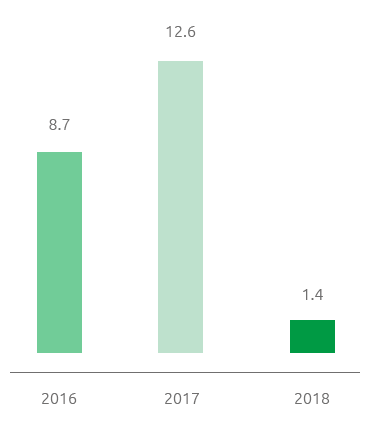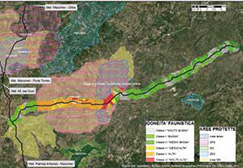Protection of biodiversity
Special attention is paid to safeguarding the natural heritage of the local areas affected by the operational activities.
Morphological and vegetation restoration operations, carried out after the installation works, are designed to reconstruct the pre-existing natural landscape as accurately as possible and to encourage the resumption of the biological functioning of the area and the development of biodiversity.
Snam’s commitment does not end with this environmental restoration, but continues with the launch of a cultivation treatment plan lasting at least five years to look after and maintain the plants and shrubs planted, which the company guarantees will become an integral part of both the restoration process per se and the environmental monitoring required by the institutions.
| Download XLS (16 kB) |
|
2016 |
2017 |
2018 |
||
|
|||||
Restoration |
227 |
203 |
227 |
||
New reforestation* |
3.7 |
21 |
21 |
||
Plant care |
98 |
59 |
74 |
||
Environmental monitoring |
565 |
388 |
445 |
||
Distance covered by pipelines in Natura 2000
networking sites (km)

Monitoring projects concern the extensions of some methane pipelines that interfere, even marginally, with the natural local areas high in fauna and ecological value, and aim to the verification of the process of re-naturalising areas affected by construction works, comparing the conditions after the restoration (“post-completion”) with the original conditions (“pre-completion”). Monitoring is normally performed for the most significant habitats identified in the design phase.
As far as storage activities are concerned, in 2018 5 shaft (mining) areas were closed and, after environmental investigations, the terrain was completely restored and returned to the owners for agricultural use (involving a total area of 28,977 m2).
The Natura 2000 sites are the main instrument in the European Union’s policy for preserving biodiversity. Established pursuant to the Habitat Directive 92/43/CEE for preserving the natural habitats at EU level, the Natura 2000 network is made up of Sites of Community Importance (SCIs), Special Areas of Conservation (SACs) and Special Protection Areas (SPAs). In 2018, Snam’s activities only involved an area of around 1.4 km (SIC IT 3120079 Lago di Loppio) for upgrading works on the “Arco-Riva del Garda” pipeline.
For the development of new sites, in addition to the technical-economic feasibility criteria, Snam adopts procedures that meet strict environmental compatibility and safety assessments.
The assessments of the environmental effects involve all the phases of the work life cycle, site selection, planning, construction, operation and decommissioning. These assessments are made within the purview of the Environmental Impact Assessment (EIA) and the Integrated Environmental Permit (IEP) procedures, at the end of which the central and local administrations issue the permits required under the current law.
| Download XLS (16 kB) |
Name |
Length (km) |
Regions involved |
Competent agencies |
Date of decree |
Pipelines |
|
|
|
|
Overhauling of the Rimini-Sansepolcro methane pipeline and ancillary works |
81.915 |
Emilia Romagna and Tuscany |
Tuscany region |
18/06/2018 |
| Download XLS (16 kB) |
Name |
number of compression units |
Regions involved |
Competent agencies |
Date of decree |
Gas compression stations |
|
|
|
|
Gallese (review for substantial modification) |
3 |
Lazio |
Ministry of the Environment and Protection of Land and Sea |
11/05/2018 |
| Download XLS (16 kB) |
Name |
Length (km) |
Regions involved |
Competent agencies |
Date of decree |
Pipelines |
|
|
|
|
Mornico al Serio-Travagliato-Chiari-Travagliato section |
24.94 |
Lombardy |
Brescia province |
03/05/2018 |
Asti-Cuneo Variants for the construction of pig launch/reception systems |
3.941 |
Piedmont |
Ministry of the Environment and Protection of Land and Sea |
26/09/2018 |
| Download XLS (16 kB) |
Name |
Length (km) |
Regions involved |
Date of submission |
Pipelines |
|
|
|
Overhauling of Ravenna – Chieti-Ravenna-Jesi section |
142.6 |
Emilia Romagna - Marche |
30/04/2018 |
| Download XLS (17 kB) |
Name |
Length (km) |
Regions – Provinces involved |
Date of submission |
Pipelines |
|
|
|
Reconnection – Connection of Torino di Sangro (CH) |
1.132 |
Abruzzo |
22/06/2018 |
Variant for PIDI insertion no. 18.2 at Chieti – San Salvo (CH) |
0.113 |
Abruzzo |
22/06/2018 |
HPRS IS64/24 bar Castellana Grotte system on Castellaneta – Castellana Grotte pipeline |
– |
Apulia |
17/07/2018 |
Tortona – Alessandria – Asti – Turin Overhaul FR 39.1 |
3.68 |
Piedmont |
26/07/2018 |
Variants S. Eufemia – Crotone Ref. S. Anna River crossing (KR) |
0.64 |
Calabria |
01/08/2018 |
By-pass for Altino 2° Tronco Variant construction of Secco River hydraulic works |
0.07 |
Abruzzo |
21/12/2018 |
Asti-Cuneo Variants for the construction of pig launch/reception systems |
3.941 |
Piedmont |
28/03/2018 |
| Download XLS (16 kB) |
Name |
number of compression units |
Regions – Provinces involved |
Date of submission |
Gas compression stations |
|
|
|
Melizzano (review) |
4 |
Campania-Benevento |
24/12/2018 |
Montesano sulla Marcellana (review) |
4 |
Campania-Salerno |
24/12/2018 |
Tarsia (review) |
4 |
Calabria-Cosenza |
24/12/2018 |
Istrana (review, renewal and substantial modification) |
4 |
Veneto-Treviso |
27/11/2018 |
